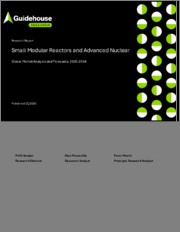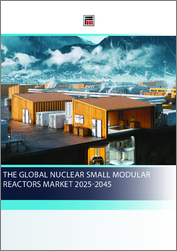
|
시장보고서
상품코드
1781120
아시아태평양의 소형 모듈 원자로 시장 : 용도별, 제품 유형별, 국가별 분석 및 예측(2025-2035년)Asia-Pacific Small Modular Reactor Market: Focus on Application Type, Product Type, and Country - Analysis and Forecast, 2025-2035 |
||||||
아시아태평양의 소형 모듈 원자로 시장 규모는 2024년 1억 10만 달러로 평가되었고, 예측 기간 동안 CAGR 14.15%로 추이할 전망이며, 2035년에는 3억 5,830만 달러로 성장할 것으로 예측됩니다.
아시아태평양에서는 공장 기반의 제조, 표준화된 설계, 유연한 배치가 가능한 모듈형 원자로 기술의 채용이 진행되고 있어 시장이 확대되고 있습니다. 각국이 에너지원의 다양화 및 탄소 배출의 삭감을 목표로 하는 가운데, 소형 모듈 원자로(SMR)는 원격지나 공업지대에 대한 전력 공급, 노후화한 송전망의 보완 수단으로서 주목을 끌고 있습니다. 또한 에너지 안전 보장 확보, 신속한 도입 스케줄, 안전 성능 향상 등의 점이 수요의 더욱 뒷받침되고 있습니다. 세계가 보다 깨끗하고 강인한 에너지원으로 이행하는 가운데, 이 지역은 원자로 설계, 디지털 제어 시스템, 고효율 제조 기술의 진보에 의해 SMR 연구의 주요 거점으로 대두하고 있습니다.
| 주요 시장 통계 | |
|---|---|
| 예측 기간 | 2025-2035년 |
| 평가(2025년) | 9,540만 달러 |
| 예측(2035년) | 3억 5,830만 달러 |
| CAGR | 14.15% |
아시아태평양의 SMR 시장은 급속히 확대되고 있으며, 이 지역의 장기적인 에너지 전략에 필수적인 존재가 되고 있습니다. SMR은 에너지 소비 증가, 탈탄소화 목표, 원격지 및 산업 지역에서 에너지 공급의 필요성에 대응하는 유연한 수단을 제공합니다. 깨끗하고 안정적이며 확장 가능한 전력에 대한 수요가 증가함에 따라 이러한 움직임을 뒷받침하고 있습니다. SMR은 공장 제조, 모듈 설계 및 신속한 도입이 가능하기 때문에 급성장하고 있는 아시아태평양의 경제에 매우 매력적입니다.
중국, 인도, 일본, 한국 등 국가들은 정부의 강력한 지원, 관민 연계, 원자력 연구 개발에 대한 투자를 배경으로 SMR 개발의 최전선을 달리고 있습니다. 해수 담수화와 전력망의 안정화부터 수소 제조 및 중공업용 공정 열 공급에 이르기까지 SMR의 용도 범위는 널리 검토되고 있습니다.
아시아태평양은 지리적 조건과 에너지 수요가 다양하기 때문에 대규모 원자력발전소 설치가 어려운 곳에서는 SMR이 전략적으로 적합하다고 여겨지고 있습니다. 또한 탄소 중립과 에너지의 다양화, 화석연료에 대한 의존저감에 대한 관심 증가가 지역의 SMR에 대한 관심을 더욱 가속화하고 있습니다. 향후 선진적인 원자로 설계와 디지털 기술의 진전에 따라 이 지역의 SMR 시장은 강력한 성장을 이루고 있으며, 이 지역에서 보다 깨끗하고 강인한 에너지의 미래를 형성하는데 중요한 역할을 할 것으로 전망되고 있습니다.
시장 분류 :
세분화 1 : 용도별
- 발전
- 열전병급(CHP)
- 해수담수화
- 오프 그리드 용도
세분화 2 : 원자로 유형별
- 수냉식 원자로
- 액체 금속 냉각 고속 중성자 스펙트럼로
- 용융염로
- 고온 가스 냉각로
세분화 3 : 발전 용량별
- 25 mw 미만
- 25-100 mw
- 101-300 mw
- 300 mw초
세분화 4 : 지역별
- 중국, 일본
본 보고서에서는 아시아태평양의 소형 모듈 원자로 시장을 조사했으며, 주요 동향, 시장 영향요인 분석, 법규제 환경, 기술 및 특허 분석, 시장 규모 추이 및 예측, 각종 구분, 지역 및 주요 국가별 상세 분석, 경쟁 구도, 주요 기업 프로파일 등을 정리했습니다.
목차
주요 요약
범위 및 정의
제1장 시장
- 동향 : 현상 및 장래에 대한 영향 평가
- 청정 에너지 솔루션에 대한 관심 증가
- 규제 및 정책 지원
- 공급망 개요
- 밸류체인 분석
- 연구개발 리뷰
- 특허출원 동향(연별 및 특허청별 특허건수)
- 규제 상황
- SMR의 경제 전제의 요약
- SMR 설계의 추정 CAPEX 및 OPEX 컴포넌트 비용
- 시장 역학 개요
- 시장 성장 촉진요인
- 시장 성장 억제요인
- 시장 기회
제2장 지역
- 지역 요약
- 아시아태평양
- 지역 개요
- 시장 성장의 원동력
- 시장의 과제
- 용도
- 제품
- 아시아태평양(국가별)
제3장 시장 : 경쟁 벤치마킹 및 기업 프로파일
- 다음 프론티어
- 시장 점유율과 전략적 노력
- 기업 프로파일
- Tsinghua University
- Japan Atomic Energy Agency
- China National Nuclear Corporation
- State Power Investment Corporation Limited
- MITSUBISHI HEAVY INDUSTRIES, LTD.
제4장 조사 방법
AJY 25.08.08This report can be delivered in 2 working days.
Introduction to Asia-Pacific Small Modular Reactor Market
The Asia-Pacific small modular reactor market was valued at $100.1 million in 2024 and is projected to grow at a CAGR of 14.15%, reaching $358.3 million by 2035. The market is expanding in the APAC area due to the growing use of modular nuclear reactor technologies, which have factory-based manufacturing, standardized designs, and flexible deployment. As countries attempt to diversify energy sources and minimize carbon emissions, Small Modular Reactors (SMRs) are gaining popularity for powering distant locations, industrial zones, and supplementing aging grid systems. Demand is also being driven by the region's emphasis on energy security, quicker deployment schedules, and enhanced safety performance. As the world moves toward cleaner, more robust energy sources, APAC is emerging as a major center for SMR research thanks to technological developments in reactor designs, digital control systems, and efficient manufacturing.
| KEY MARKET STATISTICS | |
|---|---|
| Forecast Period | 2025 - 2035 |
| 2025 Evaluation | $95.4 Million |
| 2035 Forecast | $358.3 Million |
| CAGR | 14.15% |
Market Introduction
The market for small modular reactors (SMRs) in Asia-Pacific (APAC) is expanding quickly and is becoming an essential part of the region's long-term energy strategy. SMRs provide a versatile way to meet increasing energy consumption, decarbonization goals, and the requirement for energy availability in distant and industrial areas. This is driven by the growing demand for clean, dependable, and scalable electricity. They are particularly appealing to APAC's rapidly rising economies due to their factory-based manufacture, modular design, and quicker deployment schedules.
With the help of robust government support, public-private collaborations, and investments in nuclear research and development, nations like China, India, Japan, and South Korea are leading the way in SMR development. Applications for SMRs are being investigated for anything from desalination and grid stability to the production of hydrogen and process heat for heavy industries.
The APAC region's diverse geography and energy needs make SMRs a strategic fit, particularly where large-scale nuclear plants are not feasible. Additionally, heightened focus on carbon neutrality, energy diversification, and minimizing dependency on fossil fuels is accelerating regional interest. As advancements in advanced reactor designs and digital technologies continue, the APAC SMR market is expected to experience strong growth and play a key role in shaping a cleaner, more resilient energy future for the region.
Market Segmentation
Segmentation 1: by Application
- Electricity Production
- Combined Heat and Power
- Desalination
- Off-grid application
Segmentation 2: by Reactor Type
- Water-Cooled Reactors
- Liquid Metal-Cooled Fast Neutron Spectrum Reactors
- Molten Salt Reactors
- High-Temperature Gas-Cooled Reactors
Segmentation 3: by Power Generation Capacity
- <25 MW
- 25-100 MW
- 101-300 MW
- >300 MW
Segmentation 4: by Region
- Asia-Pacific - China, Japan
APAC Small Modular Reactor Market Trends, Drivers and Challenges
Key Market Trends
- Rising interest in decentralized and off-grid nuclear power solutions across remote regions and island nations.
- Increasing government-backed R&D programs and public-private partnerships to accelerate SMR deployment.
- Growing focus on hybrid energy systems integrating SMRs with renewables (solar, wind) and hydrogen production.
- Shift toward factory-fabricated, transportable SMR modules for faster and cost-effective deployment.
- Advancements in Generation IV reactor technologies and passive safety systems.
Key Market Drivers
- Surging electricity demand in developing economies like India, Indonesia, and Vietnam.
- Need for clean, reliable baseload power to support decarbonization and energy security goals.
- Limited land availability and public resistance to large-scale nuclear plants favoring smaller, safer reactor options.
- Supportive policy frameworks, feasibility studies, and funding initiatives in countries such as China and South Korea.
- Industrial and remote site demand for compact, high-efficiency nuclear solutions.
Major Challenges
- High initial development and certification costs for SMR technologies.
- Complex and varying regulatory landscapes across APAC countries.
- Limited operational experience and demonstration projects compared to conventional reactors.
- Public perception concerns regarding nuclear safety and waste management.
- Supply chain limitations and dependency on international nuclear fuel and component vendors.
How can this report add value to an organization?
Product/Innovation Strategy: The APAC small modular reactor market has been segmented based on application, reactor type, power generation capacity, and end-user category, providing valuable insights into deployment strategies and technology preferences. Application segmentation includes electricity production, combined heat and power, desalination, and off-grid power. By reactor type, the market has been divided into water-cooled reactors, liquid metal-cooled fast neutron spectrum reactors, molten salt reactors, and high-temperature gas-cooled reactors. Capacity segmentation covers units under 25 MW, 25-100 MW, 101-300 MW, and above 300 MW. The end user segmentation includes utilities, industrial operators, off-grid microgrid providers, and desalination plant operators. This segmentation framework supports targeted market analysis and strategic planning by stakeholders across technology development, policy, and finance.
Growth/Marketing Strategy: The APAC small modular reactor market has been growing at a rapid pace. The market offers enormous opportunities for existing and emerging market players. Some of the strategies covered in this segment are mergers and acquisitions, product launches, partnerships and collaborations, business expansions, and investments. The strategies preferred by companies to maintain and strengthen their market position primarily include product development.
Competitive Strategy: The key players in the APAC small modular reactor market analyzed and profiled in the study include professionals with expertise in the small modular reactor domain. Additionally, a comprehensive competitive landscape, such as partnerships, agreements, and collaborations, is expected to aid the reader in understanding the untapped revenue pockets in the market.
Key Market Players and Competition Synopsis
The companies that are profiled in the Asia-Pacific small modular reactor market have been selected based on inputs gathered from primary experts who have analyzed company coverage, product portfolio, and market penetration.
Some of the prominent names in this market are:
- Tsinghua University
- Japan Atomic Energy Agency
- China National Nuclear Corporation
- MITSUBISHI HEAVY INDUSTRIES, LTD.
Table of Contents
Executive Summary
Scope and Definition
1 Markets
- 1.1 Trends: Current and Future Impact Assessment
- 1.1.1 Growing Interest in Clean Energy Solutions
- 1.1.2 Regulatory and Policy Support
- 1.2 Supply Chain Overview
- 1.2.1 Value Chain Analysis
- 1.3 Research and Development Review
- 1.3.1 Patent Filing Trend (Number of Patents by Year and by Patent Office)
- 1.4 Regulatory Landscape
- 1.5 Summary of Economic Assumptions for SMRs
- 1.6 Estimated CAPEX and OPEX Component Costs for SMR Designs ($/kW)
- 1.7 Market Dynamics Overview
- 1.7.1 Market Drivers
- 1.7.1.1 Advancements in Nuclear Technology
- 1.7.1.2 Growing Research and Development Activities to Achieve Near Zero Emissions
- 1.7.2 Market Restraints
- 1.7.2.1 High Initial Costs and Infrastructure Limitations
- 1.7.2.2 Regulatory and Licensing Hurdles
- 1.7.3 Market Opportunities
- 1.7.3.1 Surge in Decarbonization Policies
- 1.7.3.2 Energy Access in Remote and Off-Grid Areas
- 1.7.1 Market Drivers
2 Regions
- 2.1 Regional Summary
- 2.2 Asia-Pacific
- 2.2.1 Regional Overview
- 2.2.2 Driving Factors for Market Growth
- 2.2.3 Factors Challenging the Market
- 2.2.4 Application
- 2.2.5 Product
- 2.2.6 Asia-Pacific (by Country)
- 2.2.6.1 China
- 2.2.6.1.1 Application
- 2.2.6.1.2 Product
- 2.2.6.2 Japan
- 2.2.6.2.1 Application
- 2.2.6.2.2 Product
- 2.2.6.1 China
3 Markets - Competitive Benchmarking and Company Profiles
- 3.1 Next Frontiers
- 3.2 Market Share and Strategic Initiatives
- 3.3 Company Profiles
- 3.3.1 Tsinghua University
- 3.3.1.1 Overview
- 3.3.1.2 Top Products/Product Portfolio
- 3.3.1.3 Top Competitors
- 3.3.1.4 Target Customers/End Users
- 3.3.1.5 Key Personnel
- 3.3.1.6 Analyst View
- 3.3.2 Japan Atomic Energy Agency
- 3.3.2.1 Overview
- 3.3.2.2 Top Products/Product Portfolio
- 3.3.2.3 Top Competitors
- 3.3.2.4 Target Customers/End Users
- 3.3.2.5 Key Personnel
- 3.3.2.6 Analyst View
- 3.3.3 China National Nuclear Corporation
- 3.3.3.1 Overview
- 3.3.3.2 Top Products/Product Portfolio
- 3.3.3.3 Top Competitors
- 3.3.3.4 Target Customers/End Users
- 3.3.3.5 Key Personnel
- 3.3.3.6 Analyst View
- 3.3.4 State Power Investment Corporation Limited
- 3.3.4.1 Overview
- 3.3.4.2 Top Products/Product Portfolio
- 3.3.4.3 Top Competitors
- 3.3.4.4 Target Customers/End Users
- 3.3.4.5 Key Personnel
- 3.3.4.6 Analyst View
- 3.3.5 MITSUBISHI HEAVY INDUSTRIES, LTD.
- 3.3.5.1 Overview
- 3.3.5.2 Top Products/Product Portfolio
- 3.3.5.3 Top Competitors
- 3.3.5.4 Target Customers/End Users
- 3.3.5.5 Key Personnel
- 3.3.5.6 Analyst View
- 3.3.1 Tsinghua University
4 Research Methodology
- 4.1 Data Sources
- 4.1.1 Primary Data Sources
- 4.1.2 Secondary Data Sources
- 4.1.3 Data Triangulation
- 4.2 Market Estimation and Forecast



















